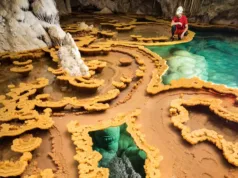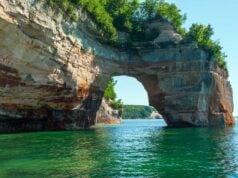The Sedona Red Rocks in Arizona are one of the most captivating and scenic natural wonders of the American Southwest. Known for their vibrant red and orange hues, towering formations, and mystical atmosphere, these rocks draw millions of visitors annually who come to explore the area’s stunning scenery, rich history, and wide variety of outdoor activities. Located within the Coconino National Forest, just a two-hour drive north of Phoenix, Sedona and its Red Rock State Park offer a unique destination for those interested in hiking, spirituality, art, and the cultural heritage of the Southwest.

Geology of the Red Rocks
The Red Rocks of Sedona are primarily made up of sandstone formations, particularly the Schnebly Hill Formation. These rocks formed over millions of years through the process of sedimentation, where layers of sand and other materials accumulated in an ancient sea that once covered the region. Over time, these layers compressed into solid rock. The rich red color that Sedona’s rocks are famous for comes from the presence of iron oxide, or hematite, within the sandstone. When the iron in the rocks oxidizes, it creates a red hue that intensifies when the sun strikes it, creating a dramatic, almost surreal landscape.
Among Sedona’s most famous geological formations are Cathedral Rock, Bell Rock, and Courthouse Butte. Each of these formations has a distinct shape and size, contributing to the area’s iconic skyline. Cathedral Rock, for instance, resembles a large, cathedral-like structure and is one of the most photographed spots in Arizona. Bell Rock is named for its bell shape and serves as a popular spot for hiking and meditation.
Spiritual and Mystical Significance

Sedona is often regarded as a spiritual mecca, known for its “energy vortexes.” Vortexes are locations where it’s believed the earth’s energy is concentrated, creating powerful healing and uplifting energy fields. There are four primary vortexes in Sedona: Airport Mesa, Cathedral Rock, Bell Rock, and Boynton Canyon. Many visitors report feeling a sense of peace, clarity, or heightened awareness when near these sites, and the vortexes have become popular destinations for meditation, yoga, and energy healing practices.
The concept of Sedona as a spiritual center can be traced back to the beliefs of the Indigenous tribes, such as the Apache and the Yavapai, who inhabited this region for centuries. They viewed the Red Rocks as sacred, and these towering structures were often part of their myths and spiritual practices. The region’s association with spirituality gained renewed interest during the New Age movement of the 1980s, and since then, Sedona has continued to attract those seeking spiritual growth, peace, and healing.
Outdoor Activities in Sedona

Sedona offers a plethora of outdoor activities that allow visitors to experience its breathtaking landscapes and natural beauty up close. Hiking is one of the most popular activities in the area, and there are trails for all skill levels. The Cathedral Rock Trail, though short, is steep and challenging but rewards hikers with stunning views at the top. Bell Rock Pathway is another accessible hike that offers views of Bell Rock and Courthouse Butte without the intense climb. For those looking for a longer trek, the West Fork Trail in Oak Creek Canyon provides a scenic, shaded hike along a stream and through the canyon.
For thrill-seekers, Sedona offers numerous opportunities for mountain biking, rock climbing, and off-road Jeep tours. Jeep tours are particularly popular, taking visitors along rugged paths and into remote areas that provide a closer look at the stunning rock formations and sweeping desert views. Many tours include insights into the geology, flora, and fauna of the region, as well as information about Sedona’s spiritual and mystical heritage.
Aside from outdoor sports, visitors can also enjoy hot air balloon rides, which offer a unique perspective on the Red Rocks, especially at sunrise or sunset. Helicopter tours are another thrilling way to see Sedona’s vast landscapes and provide an unmatched vantage point to appreciate the area’s dramatic geology.
The Art and Cultural Scene

Sedona has developed a reputation not only for its natural beauty but also as an artist’s haven. The natural scenery provides inspiration for many artists, and the town is home to a thriving arts community. Tlaquepaque Arts and Shopping Village, designed in the style of a traditional Mexican village, is a hub for local art galleries, boutiques, and artisan shops. Here, visitors can find unique Southwestern art, jewelry, pottery, and crafts.
The Sedona Arts Center, established in the 1950s, has been instrumental in fostering the arts in Sedona and offers classes, workshops, and exhibitions throughout the year. Sedona also hosts numerous art festivals, including the Sedona Arts Festival and the Plein Air Festival, where artists from all over come to capture the magic of the Red Rocks on canvas.
Flora and Fauna of Sedona
Despite its desert location, Sedona’s unique geography allows for a surprisingly diverse ecosystem. Oak Creek Canyon, which runs through the area, provides a riparian habitat where lush vegetation thrives. This creates a striking contrast between the verdant creek and the surrounding red rocks. In addition to the iconic saguaro cacti, visitors may spot juniper trees, ponderosa pines, and cottonwoods. During spring, the desert blooms come to life, adding bursts of color to the landscape.
Sedona is also home to a variety of wildlife. Mule deer, coyotes, javelinas, and bobcats are commonly spotted. Birdwatchers can delight in observing hawks, eagles, and peregrine falcons that soar above the canyons. The diversity of plant and animal life in Sedona adds to its charm, making it a paradise for nature lovers.
Best Times to Visit
The best times to visit Sedona are in the spring and fall when temperatures are mild, and the desert landscape is at its most beautiful. In the spring (March to May), wildflowers bloom, adding color to the trails and making hikes even more picturesque. Fall (September to November) brings vibrant autumn foliage, especially in Oak Creek Canyon, where the leaves of cottonwoods and other deciduous trees change color, providing a rare sight in the otherwise arid region.
While summer in Sedona can be hot, particularly in June and July, it’s still manageable with early morning or late afternoon activities. Winter can bring cooler temperatures and even occasional snowfall, creating a rare and beautiful sight of snow-capped red rocks, but most days remain mild and suitable for outdoor activities.
Conservation Efforts and Sustainable Tourism
With its popularity, Sedona faces challenges related to environmental conservation and sustainable tourism. The heavy influx of visitors can put strain on the local ecosystem and lead to issues like trail erosion, littering, and wildlife disturbance. The community has responded with various conservation efforts, encouraging practices that help protect Sedona’s unique environment.
The “Leave No Trace” principle is heavily promoted in Sedona, urging visitors to clean up after themselves and stay on designated trails. The Red Rock Ranger District and local nonprofits also work tirelessly to educate tourists on sustainable practices and have programs to restore and preserve trails and natural areas. In addition, Sedona has a robust recycling program and promotes eco-friendly transportation options like shuttles and electric bike rentals.
Final Thoughts
Sedona’s Red Rocks are more than just a scenic backdrop; they represent the fusion of natural beauty, spirituality, and cultural richness. Whether you’re hiking to the top of Cathedral Rock, meditating near a vortex, exploring the arts scene, or simply soaking in the awe-inspiring views, Sedona offers an experience that’s both exhilarating and serene. With its unique blend of adventure, mystery, and peace, it’s no wonder that Sedona has become a destination that resonates deeply with people from all walks of life.




































